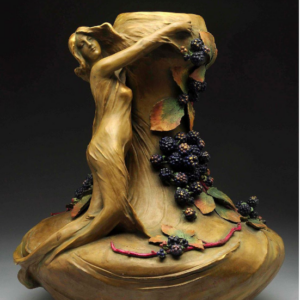What does Amphora mean in the Art Nouveau history?
There were many companies manufacturing ceramic wares in the Amphora movement, all in the Turn-Teplitz region. RSt&K and Wahliss were two of the main companies of this style.
In 1892, after 17 years as a leader in ceramics production, Alfred Stellmacher encouraged his son and sons-in-law to establish a porcelain manufactory. They were the first Amphora manufacturer. Named after its owners Riessner, Stellmacher and Kessel (RSt&K), and employing son-in-law Paul Dachsel, the firm consistently marked pieces with the word Amphora by the late 1890s and became subsequently known by that name.
Their work was introduced in the United States in 1893 at the Chicago World’s Fair where they were given the “best in show” award. Their display at the St. Louis World’s Fair in 1904 also earned high accolades bolstering their reputation as pottery masters. More than a century later, their products still have a following among pottery fans.
The departure of Paul Dachsel in 1903 and Eduard Stellmacher in 1904 marked the end of Amphora’s golden age.
Ernst Wahliss of Turn-Wein, Austria was another early Amphora art pottery designer who enjoyed success beyond the confines of Europe. Wahliss produced between 1897 and 1906 some of the most beautiful female Art Nouveau busts which are highly sought by collectors today given their beauty and technical complexity.
Wahliss was somewhat unique among the Amphora manufacturers for having established his own retail shops in London and Vienna. Another well known, high quality Amphora manufacturer was the firm of Julius Dressler whose manufacturing operation was founded in Belia, Bohemia in 1883 and operated until 1944.
The produced delicate Art Nouveau Pottery. An important series from one remarkable decade feature plants, flowers, fruits, animals (snakes, brightly plumed birds, bats), mythical creatures and dragons, biomorphic designs, and simulated jewels. Many of its artists created designs that echoed the highly ornamental paintings of their contemporaries, including Gustav Klimt and Alphonse Mucha.
Their pieces reflected the finest of craftsmanship and the most delicate of detailing and incorporated nature-inspired Art Nouveau themes in their designs.
It is a success history. During the early 20th century, Bohemia was part of the fading Austrian-Hungarian empire. Amphora was sold in the United States by finer decorating shops including Louis Comfort Tiffany of New York, who appreciated the innovative, hand crafted designs, vibrant colours, and unique glazes used by the Amphora manufacturers from Turn-Teplitz, Bohemia now the town of Trovany in Czechoslovakia.
The Turn-Teplitz region in Bohemia:
If you want to see an exquisite 5 minutes long video about this amazing pottery CLICK HERE.
If you are in Pinterest you can see +400 Amphora works by CLICKING HERE.

